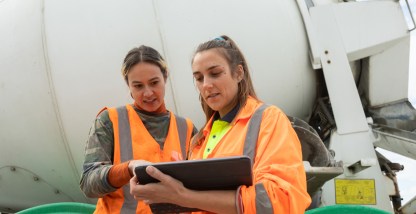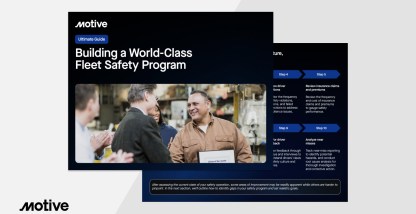From construction to oil and gas, workers are being encouraged to voice their concerns without fear of retaliation. Psychological safety has been a focus in several industries. Now it’s gaining traction in the physical economy too. Whether workers are worried about jobsite hazards or something else, employers want to know about it — before it jeopardizes safety or production.
The merits of this new safety trend have been widely publicized everywhere from Fast Company to McKinsey. But what does psychological safety entail? And how can it lead to a more engaged workforce?
Studies have shown that improving psychological safety can lead to a 12% increase in productivity. According to Google’s research on what constitutes a successful team, it’s the most crucial factor in determining a team’s success. In this article, we explain why psychological safety should be a top priority for your organization and how it can improve worksite and road safety.
Read: Drive success in construction fleet management.
What is psychological safety?
Employees in psychologically safe environments speak up, admit mistakes, and have confidence — all because they’ve been given the freedom to voice concerns without retaliation. Along the way, they become less focused on themselves and more focused on the good of the team.
As Construction Executive magazine puts it, “psychological safety creates an environment where team members can talk openly or ask for help, allowing them to get the support they need to effectively perform.”
An apprentice, for example, can voice inexperience to field management and receive proper training. A contractor can find resources to address health concerns without worry.
“When employees feel psychologically safe, they’re more likely to defend themselves and others who face bullying and harassment,” says Kevin Cannon, Senior Director of Safety and Health Services for The Associated General Contractors of America (AGC). “Voicing concerns has the potential to impact several other outcomes, including safety performance.”
Why psychological safety is often low among contractors
Today’s construction crews “struggle with serious problems that erode the effectiveness of teams,” Construction Executive writes. There’s harassment on jobsites, labor shortages, high-risk situations, and a suicide rate that’s four times the national average.
Challenges like these contribute to presenteeism on the jobsite, meaning workers are present but not fully functioning. That’s often due to illness, depression, exhaustion, or fear. As the Great Resignation continues, workers who feel they can’t voice their concerns may be more likely to seek employment elsewhere.
“These employees create a greater risk of physical injury for the rest of the crew,” Construction Executive writes. “This could be due to their distraction from the task at hand, or because they’re afraid to speak up. Either way, field management loses team buy-in, innovation, and proactive safety practices, resulting in the likelihood that not all crew members will demonstrate the safest and most productive behaviors.”
Firms can counter these challenges by offering teams a greater sense of psychological safety. Here’s where to start.
Encourage workers to speak up
“Engaged workers are those who bring recommendations to management. That’s what engagement is,” Cannon says. “When workers raise a concern that would make for a safer, more productive process and their words are received, they’ll feel more comfortable speaking up in the future.”
Frontline workers may actually have the best insight into how to complete a task safely. So use daily “toolbox talks” on the jobsite and other gatherings as opportunities to listen and learn.
“The more you can keep workers engaged, the more they’ll feel that they have a voice,” Cannon says. “When workers provide input that makes the process safer and more productive, the company can use that knowledge to enhance policies going forward.”
National Safety Council statistician Ken Kolosh encourages firms to remember the importance of buy-in at every level. “Every employee owns safety, not just managers,” he says. “Getting everyone involved is really where it works best.”
Commit to a “Culture of CARE”
AGC devised its “Culture of CARE”curriculum to encourage DEI efforts among its members. CARE stands for commit, attract, retain, empower. “A culture of care ensures that everyone, regardless of their background, feels welcome and heard,” says Cannon.
A caring culture shows concern for worker safety at every level. That concern might be expressed in written communication, conversation, or well-designed fleet safety policies. “A company that cares doesn’t just commit to the general idea of safety,” Cannon says. “They do whatever it takes to ensure that employees return home safely every night.”
Use coaching sessions to build rapport
A recent study of psychological safety in the coach-athlete relationship showed that the more freedom athletes had to be transparent with coaches, the greater their sense of psychological safety proved to be. Transparency also strengthened the relationship between athletes and coaches and helped to build trust.
If this is true in sport, it’s also true in construction. When a contractor exhibits unsafe behavior, they’ll have an easier time owning their safety lapses in a coaching environment that encourages openness, respect, and accountability.
Construction firms can use coaching as an opportunity to build psychological safety among workers. Conversations don’t even have to be in person. As workforces have become more remote, coaching has too.
Proactive safety tools like the Motive AI-powered safety platform allow contractors to self-coach right from their smartphones. Managers can follow up with contractors however they choose, reinforcing safe driving behavior virtually or in person.
Help people live their purpose at work
“Knowing your purpose at work is the most important step in developing psychological safety,” a CNBC article on the topic states. In other words, help workers understand why their work matters in the broader scope of your company and the world. Connecting safety to brand reputation or a stronger bottom line helps workers see that their efforts help everyone.
A recent McKinsey report shows that 63% of people surveyed said they want their employer to provide more opportunities for purpose in their day-to-day work. With a labor shortage continuing from one year to the next, construction firms would be wise to find ways to deliver. Otherwise, they risk losing the valuable talent they already have.
Some companies offer community service programs or paid time off for workers to pursue their passions. “While such efforts are laudable, and even beneficial, your starting point should be opportunities that help employees find more personal meaning in their day-to-day work,” McKinsey says. Employees will feel more fulfilled, and your company will benefit too.
Unlock your team’s potential with Motive
Empowering your people starts with you. See how one Motive customer used Motive technology to get safer results and build a more cohesive team.










